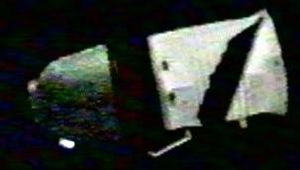
Home - Search - Browse - Alphabetic Index: 0- 1- 2- 3- 4- 5- 6- 7- 8- 9
A- B- C- D- E- F- G- H- I- J- K- L- M- N- O- P- Q- R- S- T- U- V- W- X- Y- Z
Shenzhou RV
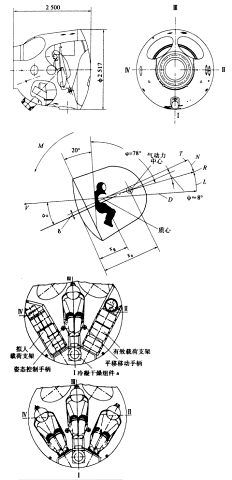 Shenzhou Shenzou DM Dimensioned Drawing |
Status: Operational 1999. Gross mass: 3,240 kg (7,140 lb). Height: 2.50 m (8.20 ft). Diameter: 2.52 m (8.26 ft).
The Shenzhou capsule was 13% larger dimensionally than a Soyuz capsule, and therefore could not use Russian hardware but instead was a scaled-up copy of the Soyuz 'headlight' aerodynamic form. The Shenzhou capsule used the same landing technique as Soyuz. The capsule deployed a single drogue, followed by a single orange-and-white main chute. The soft landing system (heat shield jettison, followed by ignition of soft landing rockets just before impact) was another Soyuz trademark.
The Cox Report asserted that the Russians provided the Chinese with a complete Soyuz spacecraft. After the launch press reports quoted "high-ranking Russian space officials" as saying that China purchased a Soyuz re-entry capsule from RKK Energia in the mid-1990's in a private deal. However the capsule supplied contained a minimum of actual hardware. Unlike the Soyuz, the umbilical to the service module differed in detail and appeared to enter the capsule higher up on the main body. The capsule provided Soyuz-style molded seats for three crew. The astronauts were presented with modern flat-panel display instrumentation. A Russian-type Vzor optical device provided a means of manually orienting the spacecraft for retrofire. Unlike Soyuz, it did not function as a periscope, and provided no forward view during docking operations. Manual control of the spacecraft was via Soyuz-type hand controllers.
The structure of the re-entry vehicle used a titanium frame, with aluminum alloy sidewalls, base, and pressure vessel. The module had the Soyuz classic 'headlight shape', with a diameter of 2.517 m and a length of 2.500 m from the forward hatch lip to the base of the heat shield. The crew entered and exited through a hatch around 70 cm in diameter at the top of the capsule. Two small portholes, around only 30 cm in diameter, provided a limited view outside. The optical device used for orienting the spacecraft manually for re-entry was similar to the Russian Vzor, but with a larger aperture. It featured eight side ports for ensuring the spacecraft was correctly aligned for retrofire. Since it did not function as a periscope and provided a view forward, future docking activities would require use of television or control of the spacecraft from a separate station in the orbital module.
The interior space of the capsule was limited to six cubic meters by the housings for the main and back-up parachutes. There were three crew sheets, facing a high-technology control panel consisting of an array of flat panel screens, caution warning panels, annunciator panels. The integrated digital display system consisted of two multi-functional color LCD displays, fed from redundant controllers. The LCD panels were high resolution, capable of displaying complex graphics. Maps of any point of the world, either the current location of the spacecraft or that of possible landing zones, could be called up at will. A voice synthesizer was integrated into the caution and warning panel to alert the crew audibly when there was any deviation to normal operations. The cabin interior was lit by individually-adjustable fluorescent lamps.
Arranged on the exterior of the capsule were six antenna mounts, the exhaust nozzles of the attitude control system used during re-entry, and a Soyuz-like patch panel for connection of gas, liquid, electrical, and electronic services from the service module. Most cabin internal equipment was installed beneath the three crew seats.
From left to right these seats would be occupied by a payload specialist, a commander/pilot, and a copilot/flight engineer. Each crew member was provided with a space suit derived from the Sokol suit used aboard Soyuz; a survival suit for post-landing situations; underwear; coveralls for working in the cabin during the mission; a headset; medical monitoring sensors; a personal survival kit, an individually-contoured seat liner; and a sleeping bag.
Each crew member's survival kit contained his selection of space food for the mission, optimized for the Chinese palate. Reserves of food were kept in case of unplanned mission extensions. There was even food in tubes that could be consumed while sealed up in the spacesuit in the event of extended cabin depressurization. The survival kit also contained a personal emergency radio beacon, smoke generator, signal rocket, flash light, dye marker, mirror, compass, life raft, pistol, knife, shark repellent, lighter, first aid kit, and emergency water.
The medical monitoring system recorded each crew member's pulse, respiration rate, body temperature and blood pressure. A medical kit provided medicines and simple instruments for in-flight emergencies and illnesses.
The environment control system regulated supply of nitrogen and oxygen to control the cabin pressure, circulated and purified the cabin air, controlled the cabin temperature and humidity control, and included smoke and fire monitoring and removal provisions. The system kept the cabin atmosphere at 81 to 101 kPa, oxygen partial pressure at 20 to 24 kPa, humidity at 30% to 70%, and temperature at 17 to 25 deg C. During re-entry, cabin temperature could go up to 40 deg C. There was a spacesuit loop for keeping the crew alive using umbilicals connected to their spacesuits in case of cabin depressurization. Provisions for disposing of body wastes and unused food have not been explicitly described. The system was fed by steel alloy nitrogen and oxygen gas bottles, at pressure of 21 MPa, located in the service module. A separate supply of gas bottles were mounted in the re-entry vehicle cabin for emergencies and during re-entry.
The guidance system determined spacecraft attitude and position using digital and analogue sun sensors, infrared horizon sensors, a strapdown inertial measurement unit, and a global positioning system receiver, all feeding triple-redundant majority-voting computers. Normally the spacecraft would be oriented and maneuvered automatically. However in the event of a system failure, the crew could manually orient the spacecraft using the Vzor device and hand controllers, and manually command and time retrofire. The computers were loaded with Chinese-developed software using novel techniques for control of the booster during ascent, in-orbit update and alignment of the inertial platform, and automated diagnosis and self-repair in case faults were detected. During re-entry the software commanded real-time flight of the capsule using lift to minimize heating and G-forces while ensuring a landing within an ellipse 30 km in range and 15 km laterally
Shenzhou radio systems used a number of new technologies including unified S-band, digital video and voice processing, remote control and voice encryption, GPS based orbit determination, ablative and microstrip antennae, and high capacity solid-state storage technology. The system had 17 antennae and operated in the C, S, L, UHF, VHF, and HF bands. The in-orbit tracking and control subsystem had a GPS receiver, S-band transponders, a C-band single-pulse radar transponder, telemetry equipment and antennae. Data transmission was via a Unified S-Band System. This was compliant to international standards and combined telemetry, command, voice and video signals into one data stream. As a back-up voice and biomedical data were redundantly combined into a second data stream and transmitted through a VHF transceiver. Three rescue beacons aided in recovery. A 243 MHz VHF beacon started transmitting after the capsule left re-entry blackout, at 40 km altitude. An HF transceiver transmitted the capsule's precise location based on its GPS receiver, and also provided two-way analogue voice communications. A 406 MHz international Emergency Position Indicating Radio Beacon provided a method of locating the capsule in case it came down away from recovery forces. The crew also had handheld emergency 406 MHz transceivers.
Shenzhou's 21 avionics black boxes communicated to one anther as a distributed computer network using a dual-redundant MIL-STD-1553B data bus. The Central Terminal Unit in the re-entry module controlled all three modules during flight. After retrofire and separation of the other modules it controlled the RV during re-entry. The Central Terminal Unit was a triple-redundant fault tolerant computer using majority voting to meet a Fail Operational -Fail Safe requirement. A second Central Terminal Unit in the orbital module was a dual-redundant computer. It would automatically come on line if the primary system in the re-entry vehicle failed. It also controlled the orbital module during autonomous missions of up to six months after the re-entry vehicle had returned to earth.
Other avionics boxes on the bus included six single-board-computer based remote terminal units, two in each module, to collect data and transfer signals; a dual-redundant data transmission and control unit in the propulsion module; 11 interface units of other subsystems; and an emergency data recorder in the re-entry module. The latter had 10 MB of solid-state memory and was built to withstand 10,000 G's and a temperature of 1200 deg C for 30 minutes.
To control orientation after separation of the orbital and service modules and during re-entry, the re-entry vehicle had eight 150 N thrust monopropellant hydrazine engines, pressure-fed from two rubber bladder tanks containing 28 kg of propellant. These were pressurized from two 4.5-litre titanium 23 Mpa gas tanks.
Following re-entry, the landing system went into operation. At an altitude of 10 km the parachute hatch was jettisoned, and two pilot parachutes deployed. These pulled out the drogue parachute, followed by the ring-sail main parachute, which had an area of 1200 sq m and a mass of 90 kg. In the event of a parachute failure, a back-up parachute with an area of 760 square meters was used. Deployment of the parachutes was guaranteed by an air-bag in the compartment (failure of the parachutes to be ejected from the compartment resulted in the death of Vladimir Komarov in Soyuz 1 in 1967).
Below 6 km altitude the heat shield was jettisoned, exposing a gamma ray altimeter and the four nozzles of the soft-landing retrorockets. As the capsule approached the ground, the capsule converted from single-point to two-point suspension under the main parachute, and its vertical velocity declined to 8 m/s. The altimeter ignited four solid propellant retrorockets at one meter over the ground, reducing final impact velocity to 3.5 m/s. In case of failure, the crew seats were fitted with shock absorbers to guarantee an uncomfortable but survivable landing. After landing, a visual flashing beacon went into operation to assist recovery forces in locating the capsule at night. If the capsule splashed down in water, fluorescent dye was released into the water to assist sighting from the air.
Many, many thanks to Chen Lan for providing original Chinese-language source material for this project, and to WXJ for the translation.
Crew Size: 3. Habitable Volume: 6.00 m3. Heat shield: 450 kg (990 lb). RCS Coarse No x Thrust: 8 x 150 N. RCS Propellants: 28 kg (61 lb).
Family: Manned spacecraft module. Country: China. Spacecraft: Shenzhou. Agency: CAST, CASC. Bibliography: 1791, 424, 460.
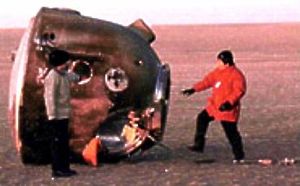 | Shenzhou Capsule Photo of Shenzhou capsule at landing site. This reveals it to be the same size and shape as the Russian Soyuz capsule. Credit: Via Chen Lan |
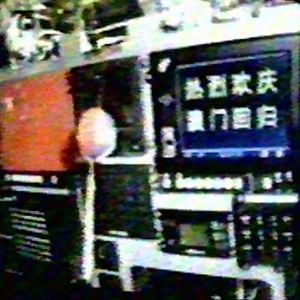 | Shenzhou Cockpit View of cockpit of Shenzhou cockpit transmitted to the ground during the flight. The instruments have a Soyuz-like layout but represent more modern looking aircraft instrumentation. |
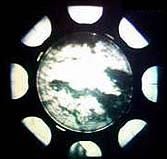 | Shenzhou Vzor |
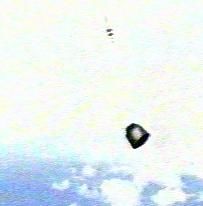 | Shenzhou recovery Jettison of drogue chute. |
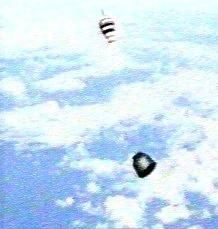 | Shenzhou recovery Drogue shoot deployment. |
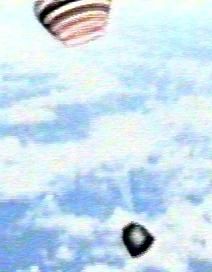 | Shenzhou recovery Main chute deployment. |
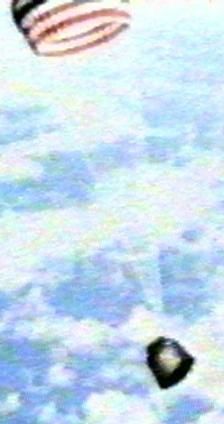 | Shenzhou recovery Main chute deployment. |
Back to top of page
Home - Search - Browse - Alphabetic Index: 0- 1- 2- 3- 4- 5- 6- 7- 8- 9
A- B- C- D- E- F- G- H- I- J- K- L- M- N- O- P- Q- R- S- T- U- V- W- X- Y- Z
© 1997-2019 Mark Wade - Contact
© / Conditions for Use
